Features of the arrangement
We can say that the working area in the kitchen takes up its entire area. This is partly true, but each zone has its own tasks - washing food and dishes, storage, preparation, cooking. And if you can refuse the hob or classic cabinets in separate kitchens, then everyone needs an empty countertop for cutting and other manipulations.
Gold standard: Even in the tiniest kitchen, it shouldn't be less than 50 cm wide. Compliance with this distance guarantees comfort during work.
Apron
The wall between the work surface and the hanging drawers must be protected apron... If there are no top cabinets, the standard 60 cm height will not be enough. The protective screen is increased to 1-1.5 m or made up to the ceiling.
There are many options for the apron:
- wall panels to match the countertop;
- tile, tile hog, mosaic;
- MDF;
- glass or skinned;
- natural or artificial a rock;
- metal;
- under a brick;
- plastic.
In the photo, red glass skins
The main requirements for a kitchen apron are ease of care, resistance to high temperatures and humidity. The most practical are tiles, skins and natural stone. They are the most expensive. In the middle price segment, there are MDF wall panels, which are easy to maintain, but can be damaged. The cheapest plastic aprons are short-lived. afraid of high temperatures.
In the photo, the wall above the workplace is made of ceramic tiles
Table top
The basis of the working area is the tabletop. It is made from different materials:
- Chipboard + heat-resistant plastic;
- artificial or natural stone;
- wood;
- tile;
- stainless steel.
In the photo, the surface is made of MDF under a tree
More often they choose a 4-cm chipboard tabletop covered with plastic. It has earned its popularity due to its wide range of designs, low cost and ease of maintenance. Among the minuses, the instability to damage is an awkward movement with a knife and the working surface is ruined by a scratch.
The high quality and reliability of natural stone is offset by its high price and limited choice of colors and designs.
There are much more options for artificial replacement - both in color and in performance. Countertops come in all sizes and shapes, including those with a built-in sink.
The popular stainless steel surface fits exceptionally modern interiors.
The photo shows a combination of black facades and steel decor
Lighting
The working area in the kitchen should be the brightest place at any time of the day. In addition to the central chandelier install other light sources in the work and dining area.
Illumination methods:
- LED strip between wall cabinets and apron;
- lamps built into the bottom of the drawers or the hood;
- ceiling suspensions over each section;
- directional ceiling spots;
- wall sconces.
In the photo, a variant of the use of LED strip
In a headset with top cabinets, install the lighting underneath. Ceiling built-in lamps in this case will not give the desired effect, but only create a shadow from the boxes. Long hangers will interfere with opening the door.
If there are no cabinets, you won't be able to hide the LED strip, but the lumens from the ceiling spots will be enough.
Natural light is equally important. The light from the window should fall from the front or left (for those who cut with the right hand).
The photo shows an example of the use of lamps in the interior without upper cabinets
Storage systems
The ability to quickly just get food or kitchen utensils, and put everything in place, reduces the time for cooking.
There are 4 main storage options:
- under the table top (lower modules);
- above the countertop (upper modules and shelves);
- freestanding cabinets and racks;
- pantry.
The latter is only suitable for organizing food stocks and rarely used appliances. Don't put things in there that you need more than once a week.
In the photo, the organization of storage in a kitchen cabinet
The rest of the solutions are suitable for the work area in the kitchen. The most logical and intuitive way to store is to arrange items into zones so that you don't have to run from one corner of the room to another. For example:
- knives, cutting boards, bowls - in the working area;
- pans, pots, salt and oil - near the stove;
- dryer, detergents and sponges - at the sink.
Avoid placing many objects on your work surface - the freer the better. Try to put as many items as possible in cabinets and shelves.
Wall cabinets are most suitable for storing food - cereals, spices, coffee, tea, sweets. The same applies to hanging shelves.
Place cooking utensils and a trash can in the floor.
Ideally, if only a kettle and a coffee machine remain on the surface of the equipment. For the rest of the accessories, consider the storage locations in advance.
The photo shows an example of additional storage on the island
Where is the best location?
Above, we have already considered one of the options for the location of the working area in the kitchen - opposite the window. But in planning it is important to consider rule of ergonomics of the working triangle... Recall that it includes 3 functional areas:
- storage (cabinets and refrigerator);
- preparation (sink and countertop);
- food preparation (hob, microwave oven, oven).
In order to select the right place for the working area, it is necessary to follow the path of the hostess: take the product from the cabinet or the fruit from the refrigerator, wash and cut, send it to the frying pan. Accordingly, the place of the table for work is in the middle of the sink and stove.
But how exactly all the elements will be located depends on the size and kitchen layouts:
- Linear set, small kitchen. The most difficult, but possible option for organizing a triangle. Suitable scheme from the corner: sink, worktop, stove, small surface, built-in refrigerator or pencil case. The same rule applies to a narrow kitchen.
- Corner kitchen... Spread the sink and stove in such a way as to leave room for work.
- U-shaped layout... Kitchens with a sink in the center look most harmonious, the hob is shifted to one side, and there is enough space between them for cutting food.
- Two-row furniture arrangement, narrow kitchen. Place the sink, stove and work area on one side. Place the storage area on the other.
- Kitchen with an island. If you have the opportunity to bring the sink to the island, the work surface can be placed there as well. If there is a stove on the island, it is better to cut food near the sink.
- Peninsula suite. To use the dining table built into the kitchen for cooking, take care of its height up to 90 cm.
In the photo, the work surface opposite the window
Finishing options
We have already mentioned standard materials for wall decoration, we also suggest considering unusual solutions.
Lining. An inexpensive and effective option for a country-style apartment or a private house. Wood is environmentally friendly, but does not like moisture and requires careful maintenance. Varnishing eliminates these disadvantages.
Mirrors. Reflective surfaces are a stylish solution for a small kitchen, which also expands the space. However, the glass must be tempered near the stove. In addition, it is not easy to take care of such an apron - you will have to wipe it almost every day.
Metal. The most practical alternative to a mirror, but it gets dirty too quickly. To make the interior not look like a public catering kitchen, make only one element steel - either a countertop or a protective screen.
What accessories will definitely come in handy?
You will cook with pleasure if you organize a comfortable kitchen for yourself. Accessories will help to cope with this task:
- Roof rails... With their help, you free up the countertop and can store towels, spices, knives and other items above it.
- Pull-out table. This solution is especially important for small kitchens - an additional work surface does not take up much space and is pulled out only when necessary - for example, if several family members are cooking.
- Roll-out baskets and boxes. Vertical storage in the kitchen makes it easy to find the items you need while cooking.
In the photo, a pull-out kitchen board
Design ideas in the interior of the kitchen
The design of the workplace depends on the style of the kitchen itself. Glass and metal finishes, plain tiles or decorative stone look harmonious in modern design.
Consider mosaics or natural stone for an idea for a work area in a classic kitchen. For country - wood panels or imitation of this material.
Photo gallery
In this article, you learned how to think over the layout of your kitchen to make your daily cooking routine easier and more enjoyable.

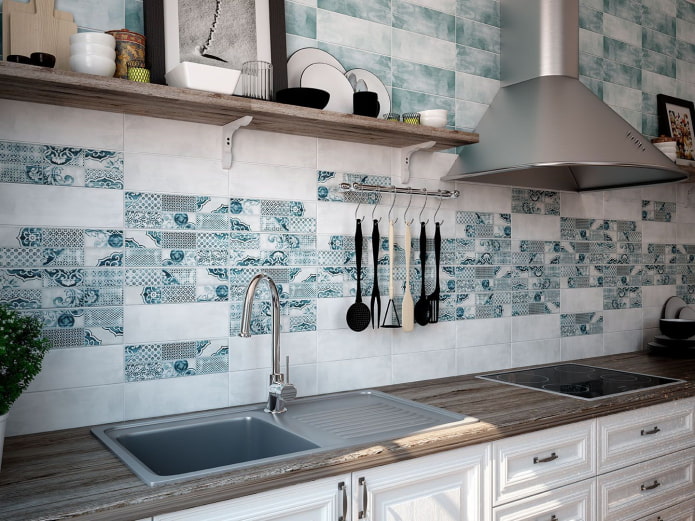
 10 practical tips for arranging a small kitchen in the country
10 practical tips for arranging a small kitchen in the country
 12 simple ideas for a small garden that will make it visually spacious
12 simple ideas for a small garden that will make it visually spacious
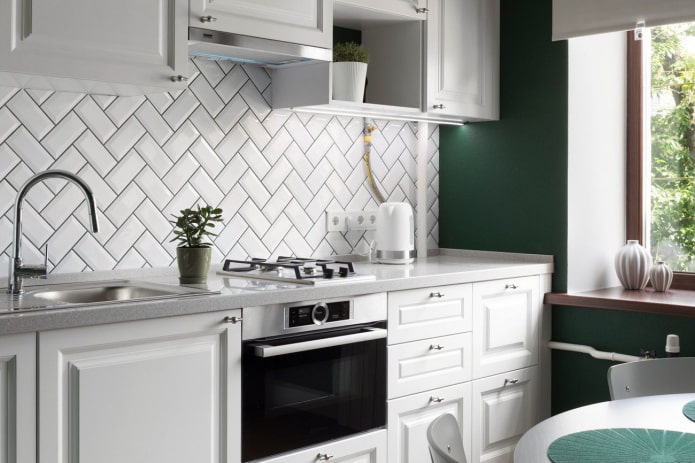
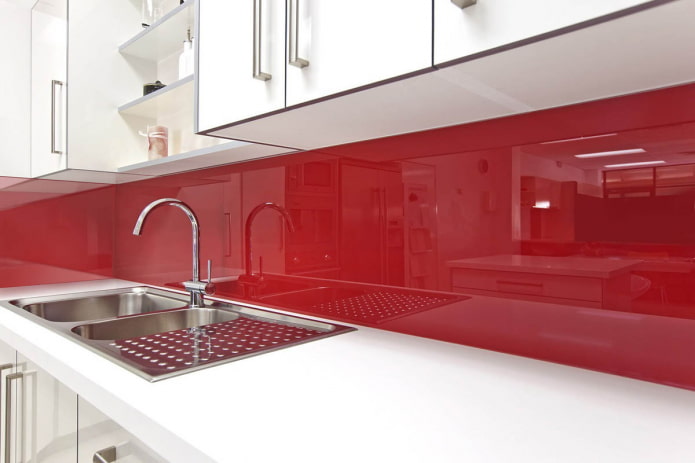
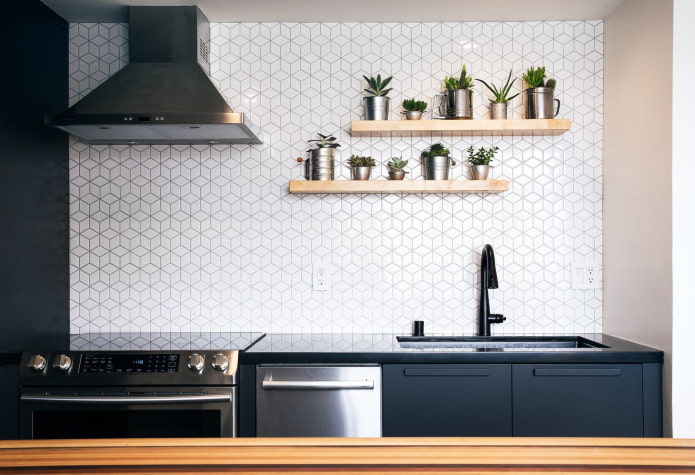

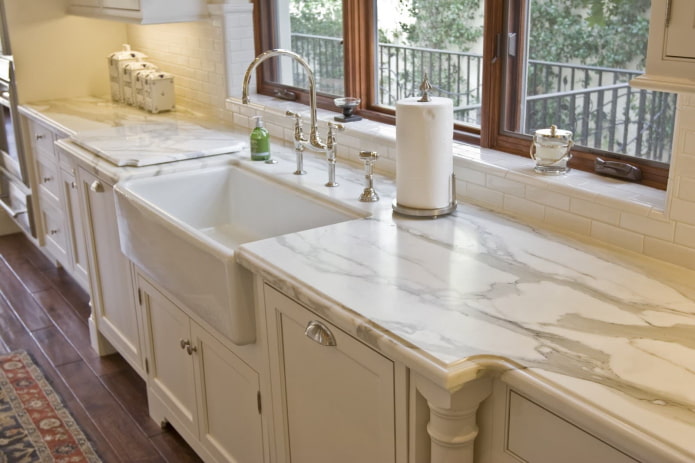
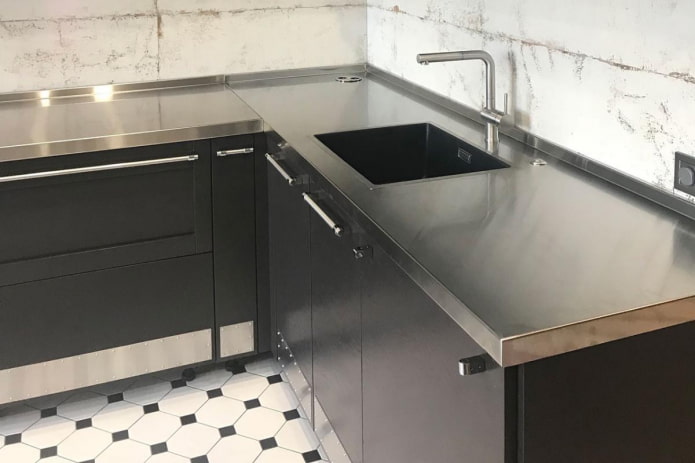
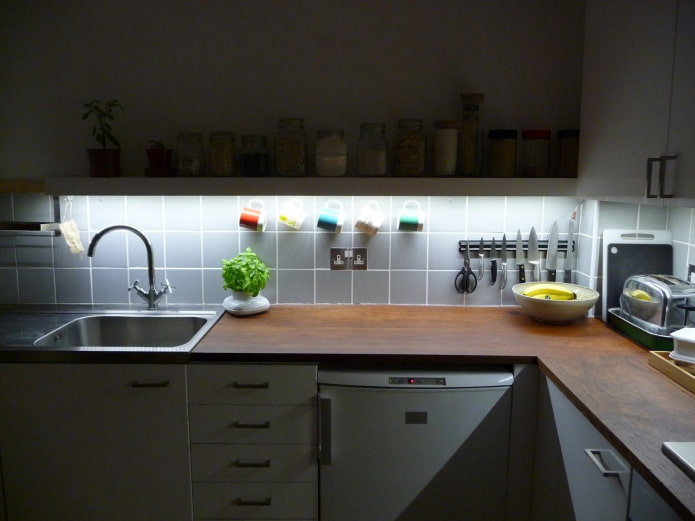
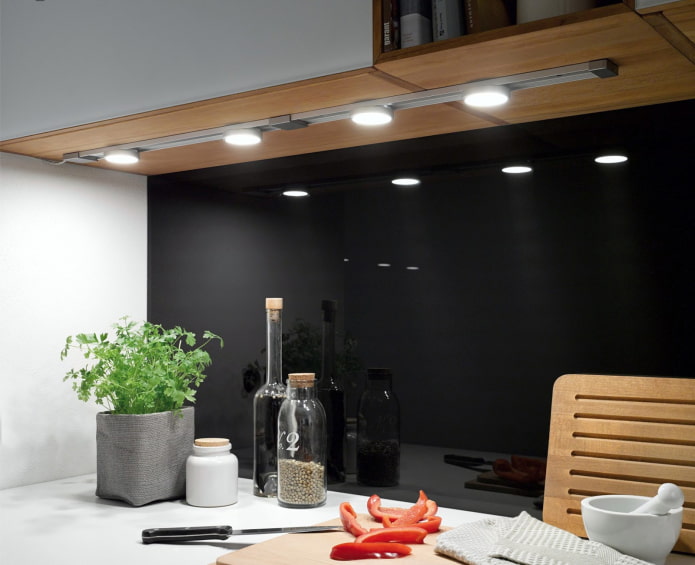
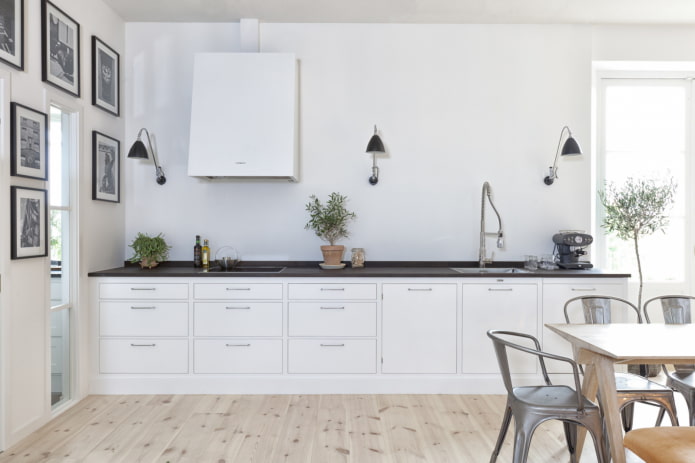
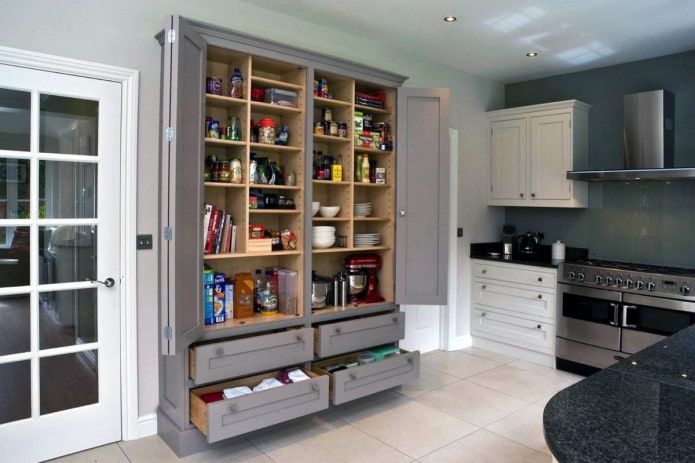


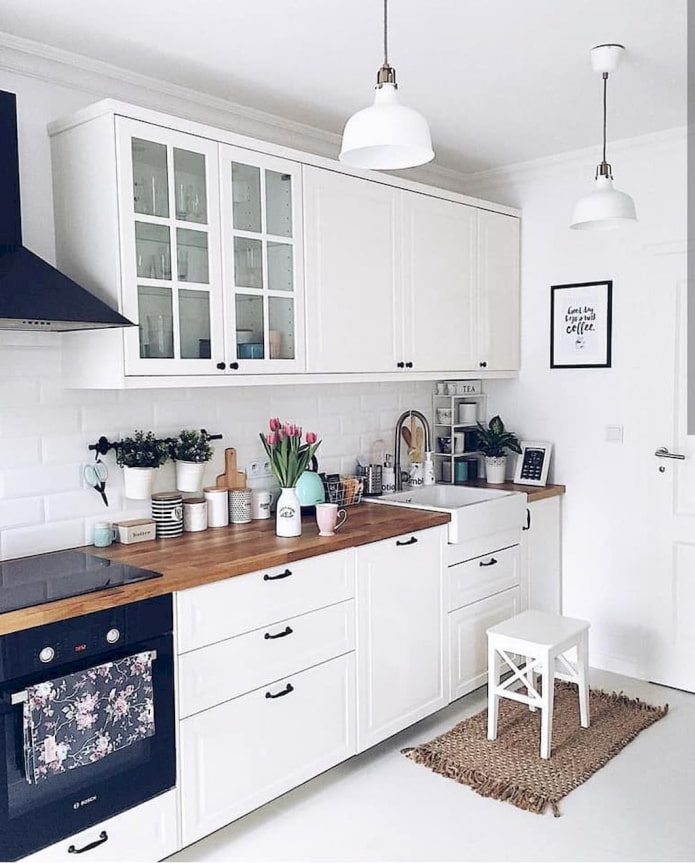
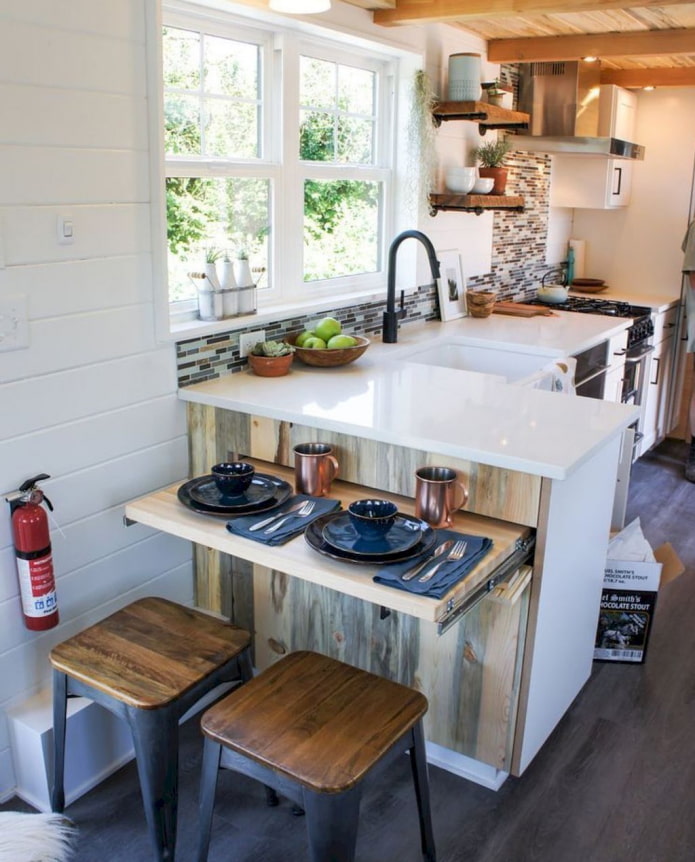
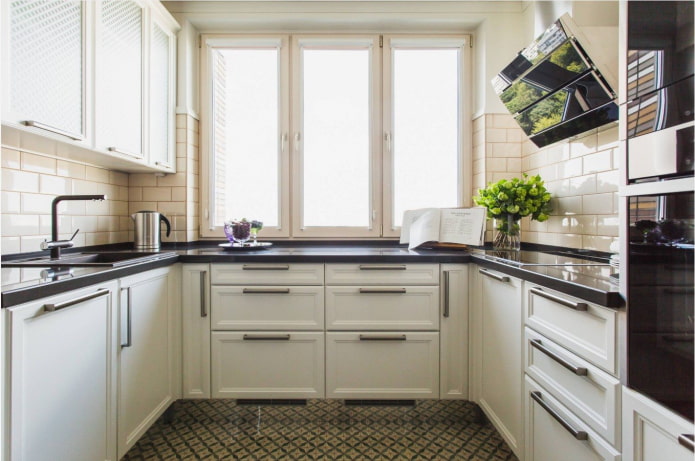

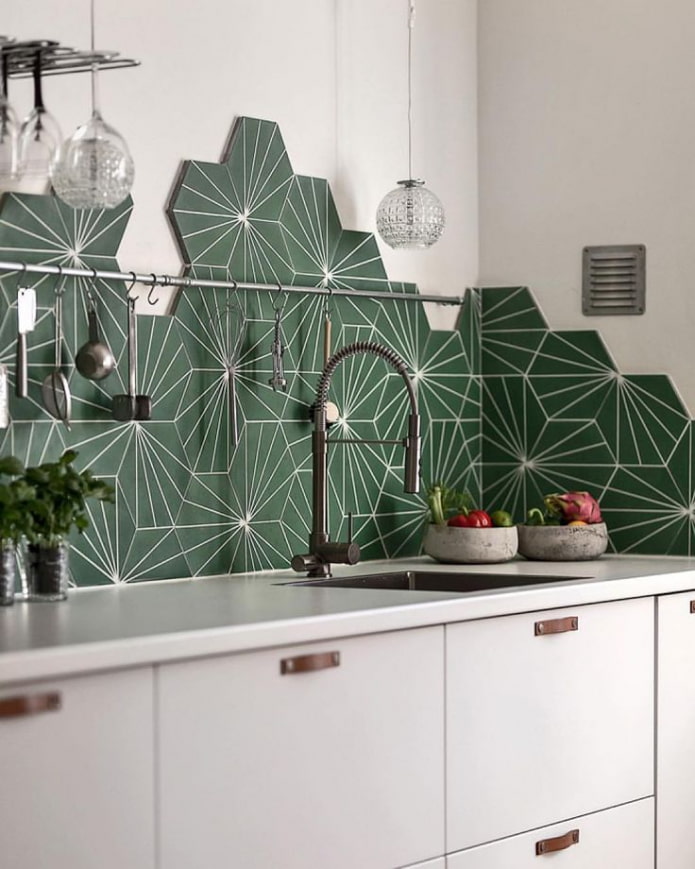
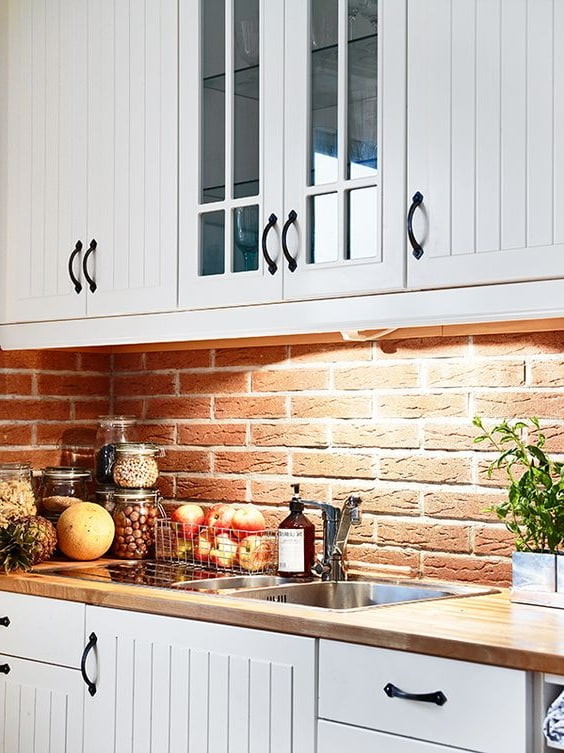

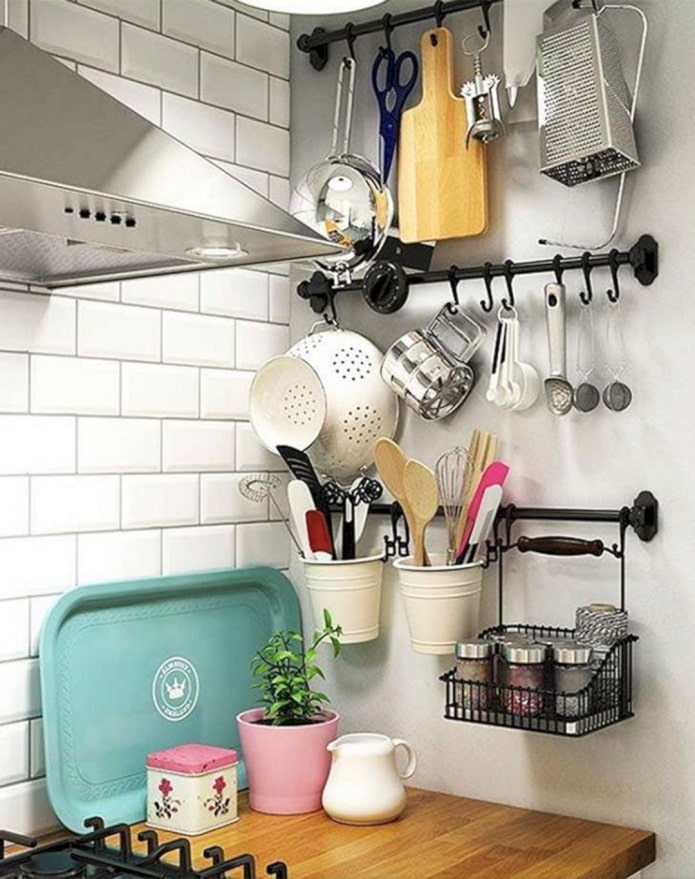
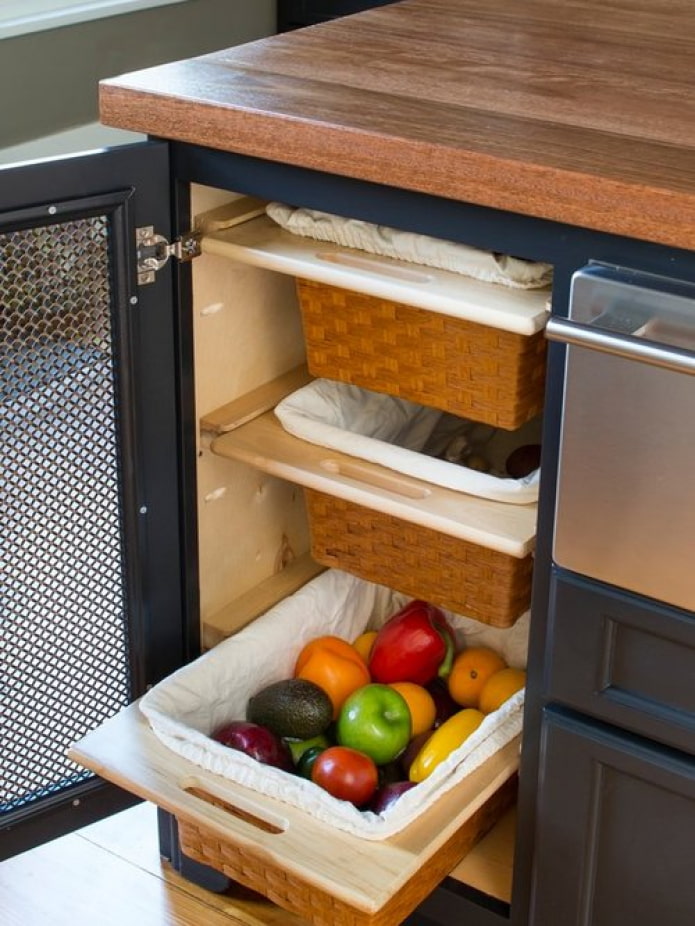
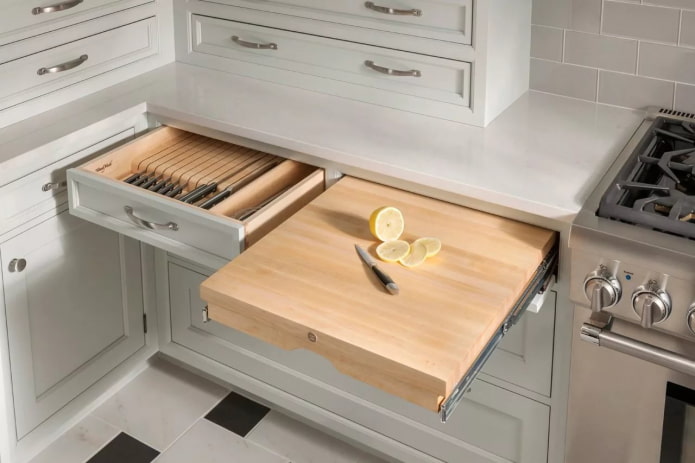
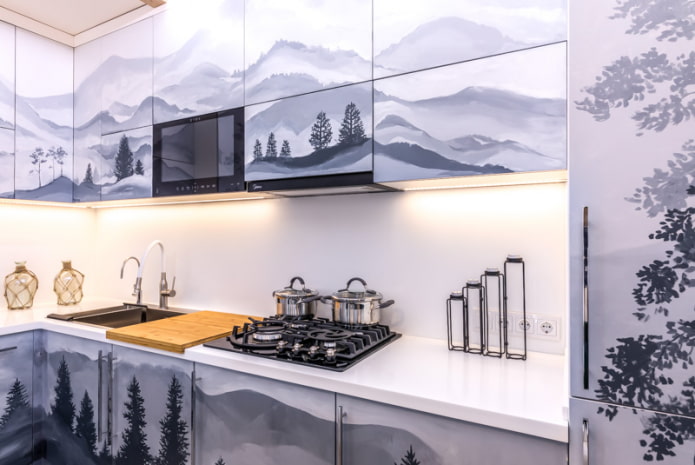
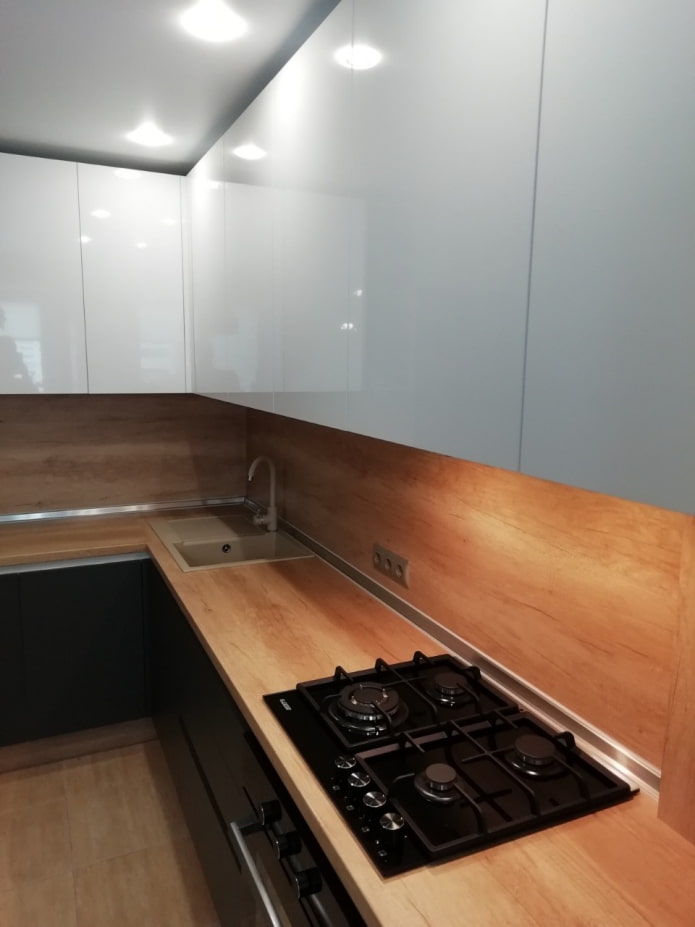
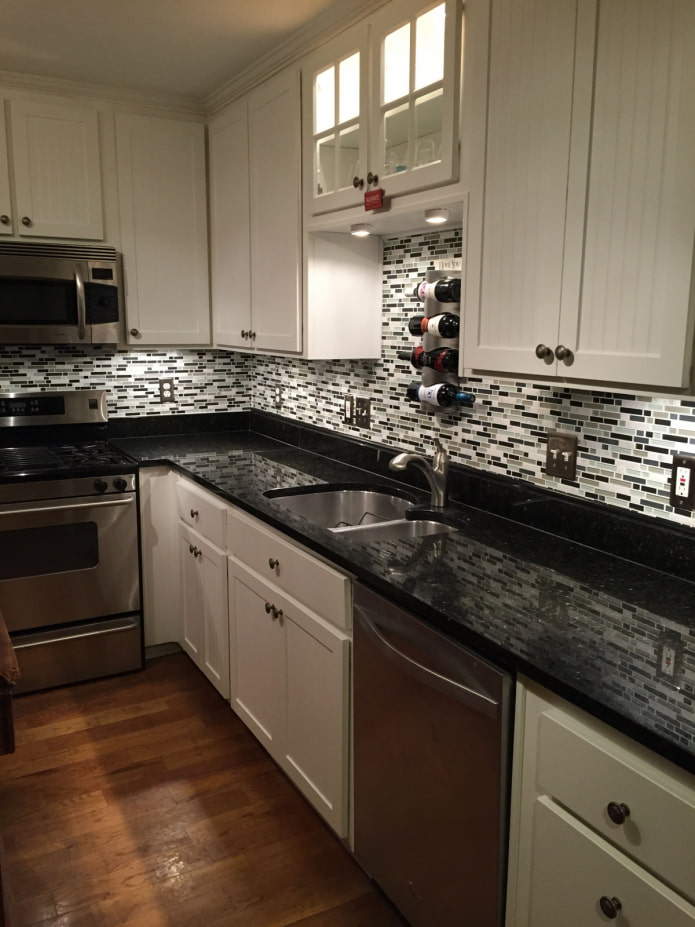
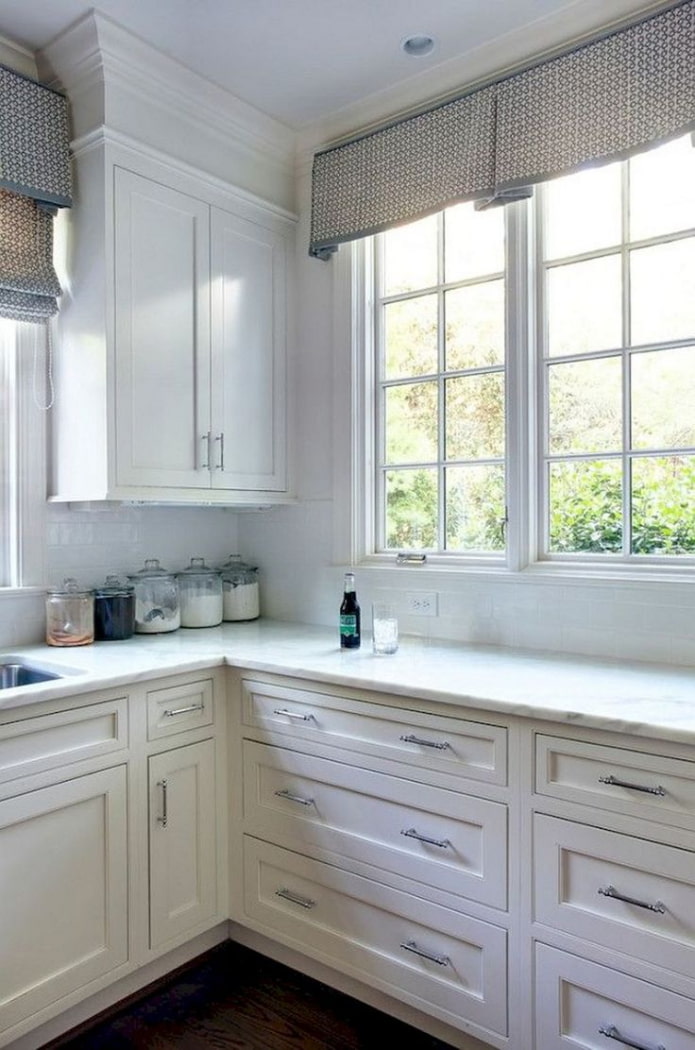
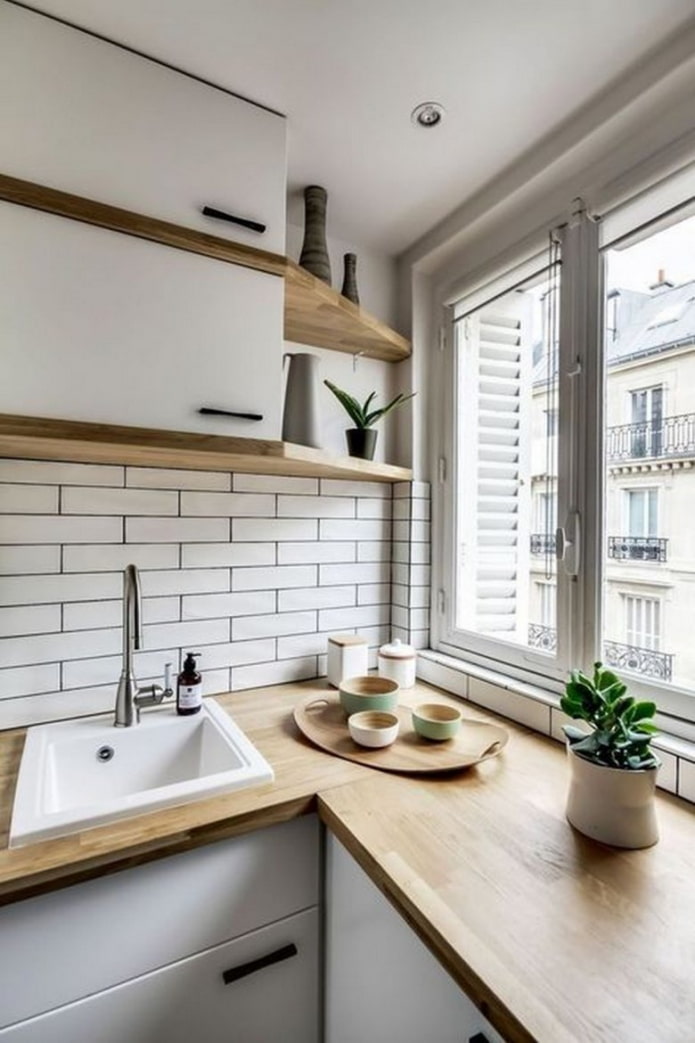


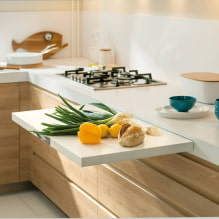


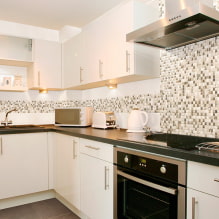
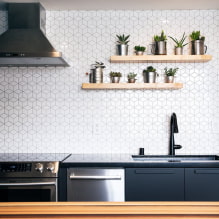
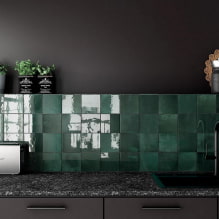

 How to choose the color of your kitchen sink?
How to choose the color of your kitchen sink? White kitchen set: features of choice, combination, 70 photos in the interior
White kitchen set: features of choice, combination, 70 photos in the interior Black set in the interior in the kitchen: design, choice of wallpaper, 90 photos
Black set in the interior in the kitchen: design, choice of wallpaper, 90 photos How to choose curtains for the kitchen and not regret it? - we understand all the nuances
How to choose curtains for the kitchen and not regret it? - we understand all the nuances Design of a white kitchen with a black countertop: 80 best ideas, photos in the interior
Design of a white kitchen with a black countertop: 80 best ideas, photos in the interior Kitchen design with green wallpaper: 55 modern photos in the interior
Kitchen design with green wallpaper: 55 modern photos in the interior